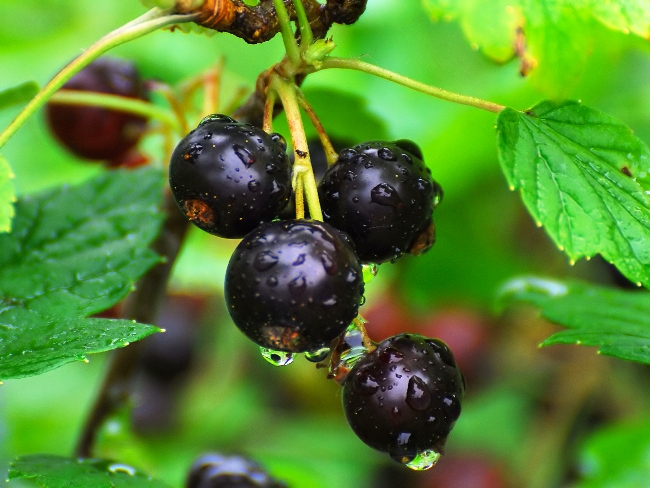Of all the types of currants black is considered the most useful. It is exactly four times as much as lemon in terms of its vitamin C content, and also rich in iron, calcium, manganese, potassium, and zinc. Not only the fruits have medicinal properties, but also the leaves of the plant, from which aromatic tea is obtained.
The health benefits of black currant are so great that it can even remove radiation from the body, which has been proven by scientists after the accident at the Chernobyl nuclear power plant. And for those for whom taste is more important, it is better to pay attention to varieties with large and sweet berries, one of which is the black currant variety Pygmy.
In this article we will analyze the description of this variety, the characteristics of the berries and learn how to deal with pests.
Table of contents
Description of a grade of currant Pygmy
The variety Pygmy was bred by breeder Ilyin V.S. during his work at the South Ural Scientific Research Institute of Fruit and Vegetable Crops. For this, the varieties Seedling Dove and Bredthorpe were crossed. Since 1999, the variety has been included in the State Register and allowed to grow in the Volga-Vyatka, Ural, and Far Eastern regions, as well as regions of Eastern and Western Siberia.
The plant itself is a medium-sized weakly sprawling shrub. The shoots are medium thick, straight, green in color. Single buds, brown, oval-shaped. The leaves are large, five-lobed, wrinkled, with teeth along the edges. The flowers are small, pale pink color.
The berries are large, round shape and bright black. The length of the brushes is average, they range from 5 to 10 berries.
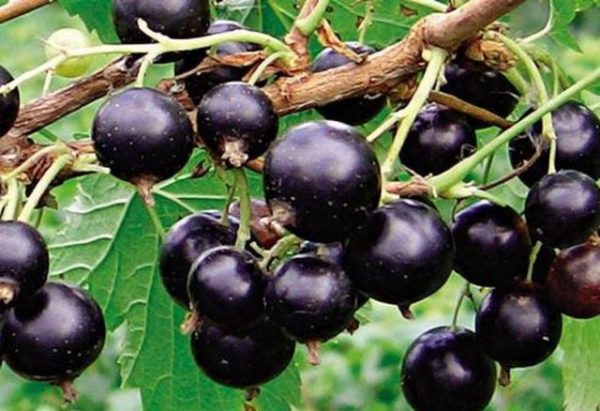
The advantages of this variety:
- High yield. From one bush collect up to 6 kg of berries. When grown on an industrial scale, the yield can reach 22.8 tons per hectare.
- Very large and sweet fruit. The weight of one berry reaches 8g. The variety is considered to be dessert, and has a score on the sweetness of the fruit 5 points.
- Long term fruiting. Berries ripen unevenly, so the crop is harvested from 3 weeks to 1.5 months.
- Samoplodny variety, consistently yielding annual yield.
- Winter hardiness Suitable for growing in regions with frosty winters, can withstand temperatures as low as 35 degrees.
- Resistant to diseases such as powdery mildew and anthracnose that are common in currants.
Among the shortcomings can be identified only susceptibility varieties Septoria and kidney tick attacks.
The variety Pygmy is unpretentious enough to care; it does not take much effort to grow it. But, like all fruit crops, the beginning of fruiting and the yield of a plant directly depends on the proper planting of the seedling.
Selection of seedlings and planting rules
When buying a black currant seedling, pay attention to the following details:
- Age.Suitable for planting annual and biennial seedlings.
- Root system The roots should not be dried and damaged.
- Branching. The better the branched bush, the faster it will take root.
It is possible to plant a currant both in the spring, and in the fall. Spring planting is best to start as early as possible after the thaw, in late March or early April, depending on the climate. The main thing is to have time to do this before budding starts, otherwise the plant will be hard to take root. But still, the autumn planting is more preferable, from the end of September to the beginning of October. If you have time to plant currants two weeks before the onset of cold weather, she will have time to settle down and get strong enough for the winter.
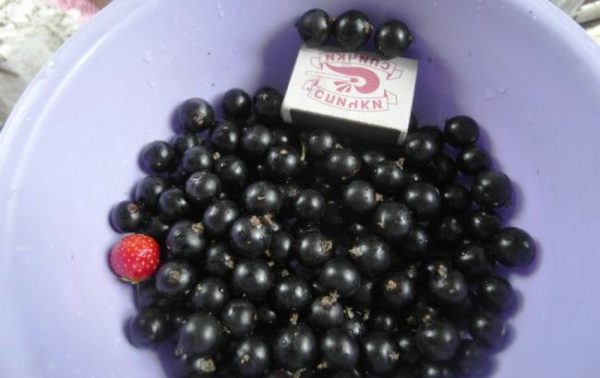
Place for planting shrubs should be well lit and protected from strong winds. Currant roots can easily withstand temporary overwetting from melting snow or heavy rains, but it will not grow on swampy soil and with a high location of groundwater.And if the soil is acidic, then it must be lime.
Planting currant seedlings includes such activities:
- 2 weeks before the estimated planting date, dig for the currant pits up to 40 cm in depth, and up to 60 cm in width. Instead of several pits, you can make one long trench. Since the variety of currant Pygmy is compact, the plants can be placed at a distance of 1-1.5 m from each other.
- When, after a couple of weeks, the land has settled, fill the hole for 2/3 with fertile soil mixed with fertilizer. You can use humus (8 kg), superforfat (200g) and potassium sulphate (40g).
- Place the seedling in the hole at an inclination of 45 degrees, while the root neck goes into the ground by 5-8 cm. Thanks to the inclined planting, conditions will be created for the growth of roots and shoots from the buds in the recessed area of the stem.
- Straighten the roots and cover them with earth. In the process of falling asleep ground, shake the seedling so that no voids form between the roots.
- After planting is complete, water the bush with 10 liters of water and mulch the soil under it with peat or humus. After 3 days, repeat and watering, and mulching.
- For rapid growth of the bush, its shoots can be cut to third.
The Pygmy variety does not require much care, but this does not mean that you can forget about the plant before the harvest begins. The most basic care measures are still necessary for him.
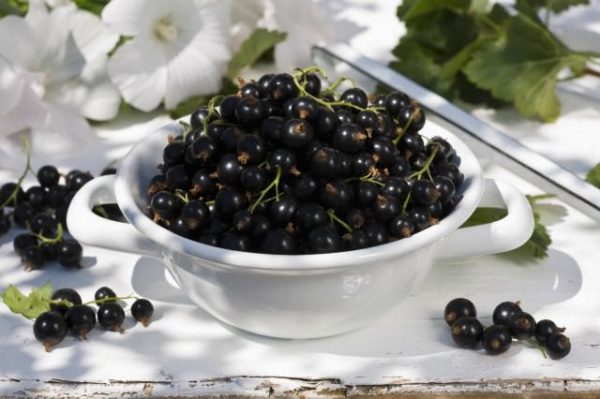
Rules for the care of black currants
Shrub care is the following:
- Fertilization. The plant consumes most of its nutrients in spring and early summer. Fertilizers should be applied to the soil in the fall and during digging in the spring, at a site of 1.5-2 m around the trunk. Soils of medium fertility require such doses of fertilizer per 1 square meter:
- For plants up to 3 years old - organic (5-6 kg), urea (15 g), sulfuric acid potassium (12 g), superphosphate (50 g);
- For plants from 4 years: organic (5-6 kg), urea (22 g), sulfuric acid potassium (15 g), superphosphate (50 g).
- Soil care. Implies its maintenance in a state, loose and cleared of weeds.In order not to harm the roots, you can loosen the ground at 8 cm near the bushes and at 12 cm in the aisle. To reduce the number of treatments allows soil mulching with peat, humus or manure. Land under the mulch longer retains moisture and friability.
- Watering. It is necessary, especially if the dry period fell during the formation of the ovary. In the case of a dry autumn, before the onset of frost, it is also necessary to water the shrub (up to 5 liters per 1 square meter), because overdried soil can cause freezing of the bushes in winter.
Diseases and pests of black currant
Variety Pygmy resistant to most diseases of currants. The only disease that needs to be protected is septoria, another name is white spot. This is a fungal disease, the symptoms of which will be the appearance of specks on currant leaves up to 3 mm in diameter.
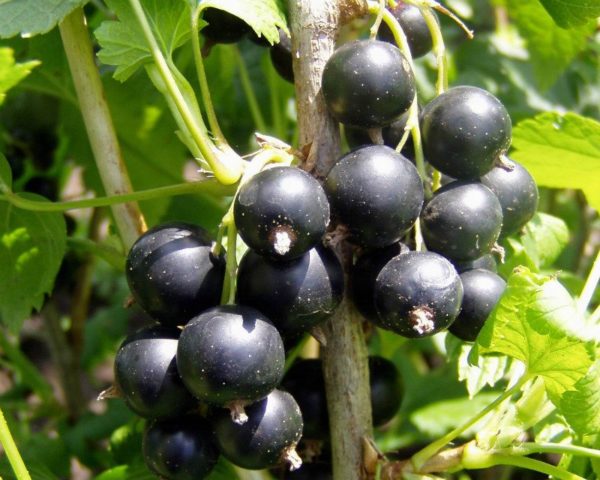
At first they are completely brown in color, then turn white in the center, and remain brown only at the edges. The fruits of the plant can be covered with small spots.With a strong defeat, the whole foliage can fall completely on a currant.
To combat the disease, the bushes and the ground beneath them should be plentifully sprayed with copper sulfate or nitrafen solution. It is important to do this before the bud starts blooming in spring. Well in such cases helps and Bordeaux liquid, which is diluted in the amount of 100 g per 10 liters of water. She needs to process currants immediately when the first symptoms appear, and a second time 10 days after harvesting.
Of insect pests, the Pygmy variety is most susceptible to kidney mites. This is a small insect 0.15-0.3 mm in length, hibernating in the currant buds. In the spring, after awakening, the females lay larvae in the kidneys, which, as they grow, spread to the whole plant. Damaged buds cannot develop, and the sprout, if it grows from them, will be mutated. In addition to reducing the number of shoots and lower yields, the pest is also dangerous with the ability to tolerate viral diseases.
Pest Control Measures:
- Boiling water. The safest and most effective way. All larvae die from boiling water, and the plant itself is not harmed. Just do not need to pour 100-degree boiling water over the bush, the water should cool down a little while you bring it into the garden and pour it into the watering can. For efficiency, tie the branches to make the plant more compact. The method can be used only until the kidneys awaken, otherwise they may be harmed.
- Manual removal of affected kidneys. The method is painstaking, but safe. Kidneys with mites will be swollen and more round. It is better to carry out such sorting in the autumn, because in the spring it is easy to confuse an infected kidney with a bud with an incipient shoot.
- Colloidal sulfur. It is dissolved in water in an amount of 10 g per 1 l of water. Shrubs are processed at the beginning of the flowering period and immediately after its completion. This method is suitable for critical situations when there is a question about saving the life of a plant. Such processing may spoil the harvest, but it will recover next year.
- Crop. The most cardinal way. If the insect cannot cope with other methods, then it remains only to cut the bush under the root in autumn and wait patiently for the plant to grow again.
In order not to have to use such extreme measures, you need to take care of your currant. Plants that are regularly fed, pruned and prophylactically treated will be highly immune to diseases and pests.
Benefits and tastes of black currant Pygmy are worth it to make a little effort to care for her. With proper planting, the plant will stably bear fruit for at least 10 years, and with regular care of growing conditions and protection from pests, the fruiting period can be extended even up to 20-25 years.
